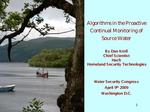Description
This study is focused on analyzing the biofouling potential of reverse osmosis (RO) colonizing bacteria producing large amounts of extracellular polymeric substances. The effect of bacterialdeposition on an irreversible attachment of the colonizing strain on biofouling propensity was analyzed. A model strain, Pseudomonas aeruginosa PAO1 mucA22, a mucoid that constantly produces high quantitiesof alginate was used as a biofouling agent. Deposition of the mucA22 mutant and its isogenic wild type (where alginate expression is under control) was tested microscopically in a radial stagnation point flow(RSPF) system as well as biofouling runs in a crossflow rectangular plate-and-frame membrane cell where biofilms of the wild type and its mucoid strain were cultivated on a thin-film composite, polyamide, flat ROmembrane coupon (LFC-1) under laminar flow conditions. In the RSPF system, the observed deposition rate of the mucoid strain was between 5- to 10-fold lower than of the wild type. Corroborating with theseresults, a significant deceleration in biofouling of the RO membrane was observed when the mucoid strain was inoculated as the membrane colonizer. The reduction in cell deposition of the mucoid strain wasobserved to be mainly affected by 5- to 25-fold increased hydrophilicity. Furthermore, a greater number of negative cell-surface zeta-potentials were observed, under all conditions, when alginate was expressed in a higher extent.
Product Details
- Edition:
- Vol. – No.
- Published:
- 11/01/2009
- Number of Pages:
- 1
- File Size:
- 1 file , 750 KB
- Note:
- This product is unavailable in Ukraine, Russia, Belarus





